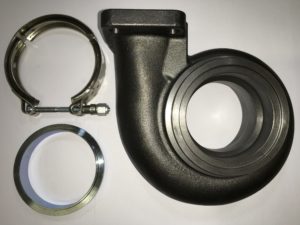Looks like a fun project! I just happen to have done a lot of this sort of thing for many years, and I've been paying it forward where I can help. I have helped many, and have more-or-less found what it takes to make smiles and avoid frustrations. You are the point of your project, so you have to be honest with yourself. While there can be a lot to say, I have some random thoughts that may help you in your decisions, in no particular order, and calculated from stock engine spec's:
The HX35 is borderline and blowing quite hot at your calculated flow. You may want to consider a turbo that is more suited for flow (than high pressure) and with a turbine housing that will spool at reasonable rpm. While several options; bang the the buck could be a Garrett TP38 or GTP38, as used on the 7.3L diesels, with a .84 or 1.0 hot side to get boost where you need it. A hint is that your engine is a 5L, so stuff that works for a stock 302 can often work for this.
Anything that helps NA power, airflow and exhaust flow will help make more power on boost. Holding rpm to reasonable levels aids reliability. Boost is fine. RPM is fine. Getting greedy with boost and RPM is risky. Stock parts are fine for street boost levels, with typical upgrades you would do for NA. High-rpm NA mods are not the right direction for lower-rpm and boost. Use good fuel, good tuning, and appropriate ring gaps. Use (mostly) what your engine has and make a baseline, which will then clearly show where the combo needs help to make more performance most effectively.
42lb injectors are about right for the 425+ hp this combo could make at 2-bar (15 psi) at 5000 rpm. Limiting to 12 psi? About 400 on tap. Use whatever manifold gets you there the quickest, or cheapest, or that you can fabricate or mod easily. One of the goals at this point is to get it done in the first version as quickly and inexpensively as possible. Why? Because once you have a baseline of what it can do in that first form, you will know exactly how it needs to change to get you to your next goals. There are always things that work differently than you expected, and always next goals. No more guessing, and you get where you want quicker and cheaper.
MS3X is fine, although far more than you need for this. You don't need bells and whistles, you need basic, easily-tuned control. Unless you know how and why you need it, go slimmer. MS2, Speeduino, RusEFI, etc. No reason you can't get this thing huffing hard with a $200 ECM, $100 WBO2, and $60 in tuning programs. There are a ton of turbo LS engines running hard on MicroSquirt, or the sub-$100 NO2C, as an example that more is not always better. Expensive does not guarantee better for the tasks or to meet your goals. Pick for the tasks, not the name or price.
Pick parts for what they must do, not what they are. This will break through limitations that block options and solutions you could use. Your greatest performance and best insurance for reliability rests with diagnostic tuning. Budget more time for that.
Almost any ignition can do the job. Cheap is the stock distributor, altered for control by ECM. Efficient is a crank wheel and coil packs or LS coils on the valve cover. There are 101 versions of ignition to choose from that aftermarket ECMs can control, so your goals list should specify the choice direction based on easy, fast, cheap, or whatever the balance of primary goals are.
This brings the last random thought - your project goals list. This is the most important part of the project. You need to clearly spell-out what this thing is expected to do. Be specific, as you can't reach goals you don't have or are unclear. Put some performance measurements to it, like speed, torque, MPG, whatever. Put some jobs to it, like highway trips, commuter trips, track racing types, whatever. Put a realistic budget to it. Bling, sound, appearance and silly stuff is OK on the list. From that you can make a specific and detailed plan to reach the goals, and that means getting there cheaper and quicker. Follow the plan, and have fun!



